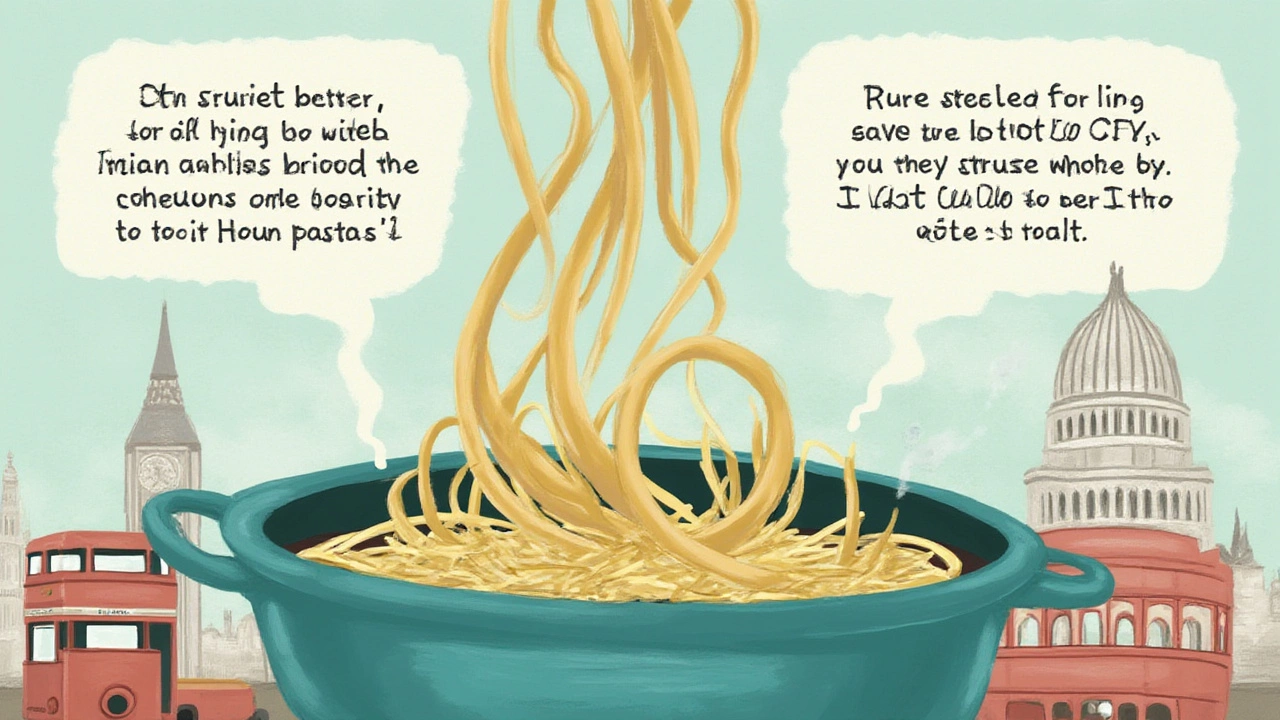You’ve got a pot of boiling water, a fistful of spaghetti, olive oil glistening on the counter, and one big question that pops up every single time—should you actually put a splash of that olive oil in pasta water? The rumor is everywhere: someone’s grandmother swore by it, a celebrity chef might’ve tossed some in, and maybe your Italian friend just shrugged. The truth behind this habit is way more interesting (and controversial) than most folks realize. So let’s roll up our sleeves, bust some kitchen myths, and find out what really goes on in the kitchens of Italy—and what’ll help, or hurt, the pasta you crave.
The Myth of Olive Oil in Pasta Water: Where Did It Come From?
If you’ve cooked pasta even once, chances are good someone’s whispered, “Add a little olive oil to the water. It keeps it from sticking.” But is this an authentic tip from the hills of Tuscany, or is it just a stubborn kitchen legend? First, let’s track down the roots of this idea.
For decades, American and British kitchens have repeated this advice in magazines, cookbooks, and television cooking shows. Italians, especially home cooks and traditional chefs, tend to roll their eyes at it. The phrase, “Non mettere olio nell’acqua della pasta!” (“Don’t put oil in the pasta water!”) is almost a rite of passage in Italian cooking classes. Yet, this myth persists. One possible reason? In some restaurant settings, especially in banquets or hospitality situations where huge vats of pasta are cooked to feed the masses, a bit of oil gets tossed in to help large batches avoid sticking while sitting (not during active cooking). But at home and in real Italian kitchens, it’s nearly unheard of.
The myth seems to stem from basic kitchen misunderstandings. Yes, olive oil can reduce surface tension, which might stop some foam from bubbling over. But it never becomes part of the pasta—it just floats on top. For decades, food personalities and best-selling guides carried this forward, even when actual Italian cooks did not do so. Plus, American pasta brands in the early 1900s marketed olive oil as a premium additive, linking it with “authenticity.” The marketing worked so well that the myth still lingers today, despite endless pushback from Italian grandmothers.
Do Italians Actually Add Olive Oil to Pasta Water?
This is where tradition speaks loudest. Walk into an Italian kitchen—north or south, city or countryside—and you’ll almost never see anyone reach for the olive oil bottle before draining their pasta. Why? Ask any Italian nonna, and she’ll tell you: olive oil belongs on finished pasta, not in its bath.
Here’s how it really works in Italian homes: The pasta is cooked in lots of well-salted, rapidly boiling water. That’s it. No oil. Italians consider salt essential to flavoring both the water and the pasta itself, but oil in the water? Forget about it. There’s a practical reason: oil floats. It doesn’t integrate into the water or stop the pasta from sticking. Instead, a little stirring, especially in the first couple minutes, keeps things moving and tangle-free. And, if you’re using quality dried pasta—even supermarket brands from Italy—the chance of sticking drops way down.
Italian chefs and home cooks agree: adding oil makes it harder for sauce to stick to the noodles later. If you coat pasta with oil at any stage before sauce, you’ll likely get slippery noodles and sauce that slides right off. In fact, some Italian restaurants overseas do it on purpose when prepping for large buffets, just to keep food looking good under heat lamps—not for taste or authenticity. This is a trick, not a tradition.
If you want to see just how rare it is, try asking some older Italians in different regions—Liguria, Sicily, Puglia. Most will react with a laugh or a “Perché vuoi farlo?” (“Why would you do that?”). It’s basically kitchen heresy. If you visit a real trattoria in Naples or Rome, you’ll find olive oil front and center on the table, used on salads and drizzled over bread, but nowhere near the pasta pot during boiling. It’s a finishing touch, never a boiling ingredient.

Science in the Sauce: What Actually Happens When You Add Olive Oil?
Here’s where things get technical—but don’t run! The science is simple and it matters. Pour olive oil into a pot of boiling water, and you’ll see it sits on the top, forming glossy bubbles. The pasta stays underneath, cooking in watery bliss, without touching that floating oil during most of the process. So, despite the wishful thinking, the noodles aren’t actually being lubricated as they cook.
Why do some people insist it helps? Oil does do one small thing: it helps keep the water from foaming and boiling over, especially when cooking fresh egg pasta. Fat tamps down surface bubbles, which is handy but not necessary for most home cooks. But in terms of keeping noodles from sticking, it’s the wrong solution. The real cause of sticky pasta? Not enough water or not enough stirring. Pasta releases surface starch as it cooks; too little water means that starch gets thick and syrupy, and noodles glue together. Stirring in the first two minutes is your secret weapon. Olive oil? Not so much.
Some chefs point out another negative: adding oil can create a sliding barrier on the pasta’s surface. This keeps sauces—especially ones like ragù, carbonara, or creamy pesto—from gripping and mellowing with each strand. Studies from food labs in Italy have shown that even a little oil changes the way starch interacts with sauce, reducing the famous creamy, clingy texture of a classic Italian plate.
Let’s break it down a bit with a quick cheat sheet:
- Olive oil in the water: Doesn’t stop sticking, floats on top, and can make sauce slip later.
- Stirring pasta well:
- Prevents clumps, keeps things separated, and works every time.
- Enough water and rolling boil:
- Dilutes surface starch, keeping noodles from gluing up.
- Salting the water properly:
- Adds flavor to pasta itself. (Italians use roughly 10-12 grams salt per liter!)
Here’s a quick look at a sample cooking comparison, in a table based on data from a 2022 test kitchen trial:
| Method | Did Pasta Stick? | Did Sauce Stick? | Texture |
|---|---|---|---|
| Oil in Water | No (seldom), but pasta surface oily | No, sauce slid off | Slippery, less flavorful |
| Stirred, No Oil | No, perfectly separated | Yes, sauce coated evenly | Aromatic, authentic bite |
The science is clear: your best bet is plenty of vigorously boiling salted water, a big pot, and a cook ready to stir. Save that beautiful olive oil for after the boil, where it absolutely shines.
How Italians Really Use Olive Oil When Cooking Pasta
So, if olive oil doesn’t go in the water, where does it belong? On the table, in the sauce pan, or finishing the plate. Italian cooks are obsessed with olive oil, but they’re precise about where and when they use it. Here’s how the pros do it:
- In sauces: Olive oil is the bedrock of many Italian sauces. Think garlic sizzling in oil for aglio e olio, or the base for tomato sugo. The flavor it adds is unbeatable, and it carries aromatics like basil, chili, and onion beautifully.
- As a finishing touch:
- Ever noticed the rich sheen on a bowl of cacio e pepe or linguine alle vongole? That’s just a whisper of extra-virgin oil drizzled on just before serving. It catches light and packs a fruity punch.
- With fresh pasta:
- Some cooks will lightly toss fresh pasta with a bit of oil (after draining, never in the pot) if it’ll be sitting for more than a minute or two. This stops clumping without making the pasta impermeable to sauce.
- In salads and cold pasta dishes:
- For pastas served cold (insalata di pasta), olive oil keeps things supple, glossy, and adds taste. This is one time olive oil is used as an actual barrier between noodles.
Interesting fact: Olive oil consumption per capita in Italy is nearly 13 liters annually, according to a 2023 survey from ISTAT. Nearly all of it is used at the table or as a cooking fat—not as an addition to boiling water!
And here’s a pro tip: when making classic sauces like pesto, Italians often stir in some starchy pasta water (before draining), then finish with a generous glug of aromatic oil. That’s what gives the sauce its thick, creamy coat and keeps flavors bright and punchy. Adding oil at the wrong moment dulls everything down.
Younger Italian cooks are experimenting with flavored oils, fancy bottlings, and even pairing oils with certain pastas. But even in these trendsetting spots, the oil never goes into the pot during boiling. Instead, you’re likely to find oil tastings before dinner or custom pours to pair with specific pasta dishes—think oil as the star, not as a background bit-player.
And, if you really want to go traditional, ask for "olio nuovo" in the fall, when the freshest-pressed oils hit the market—intense, almost spicy, and totally different from the bland supermarket stuff. Drench your post-cooked pasta in that golden green stuff, and you’ll finally taste why Italians respect their oil too much to waste it in boiling water.

